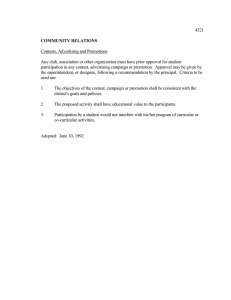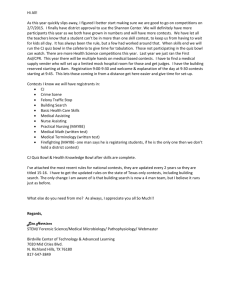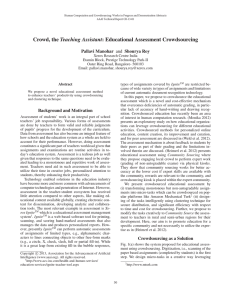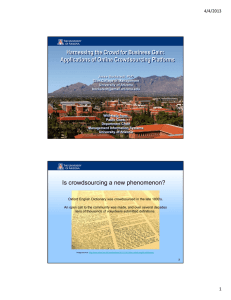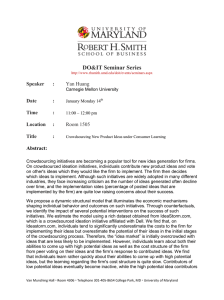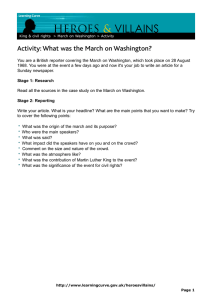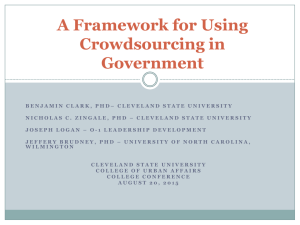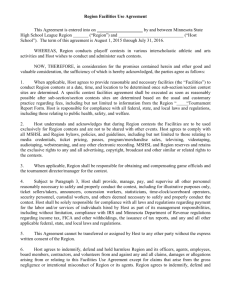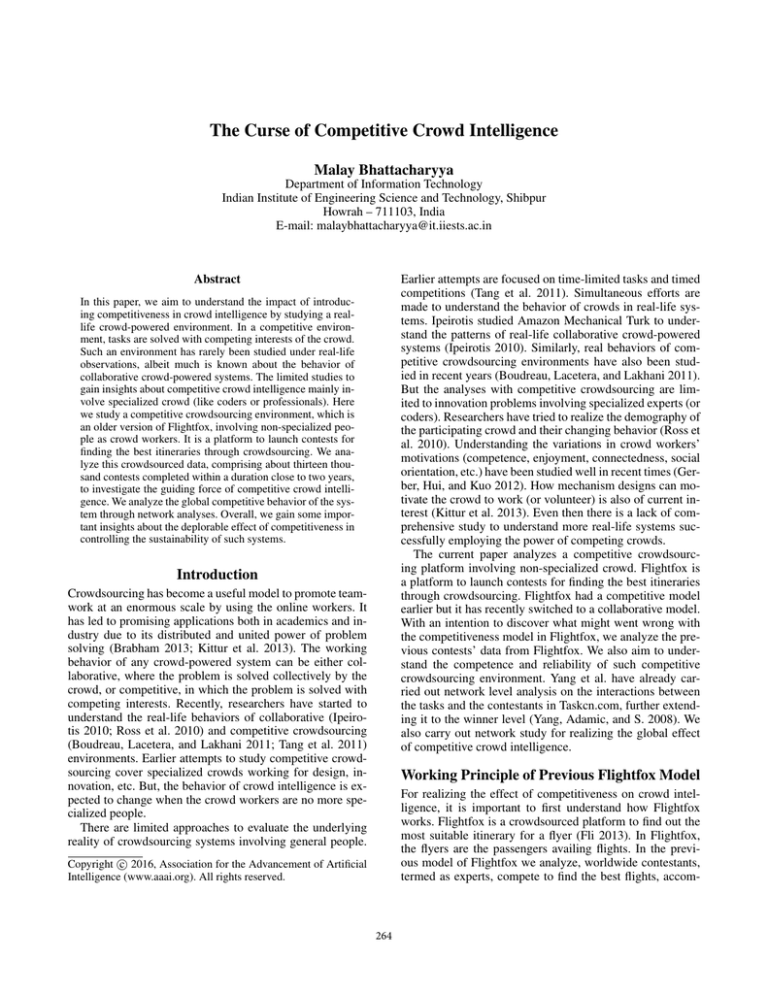
The Curse of Competitive Crowd Intelligence
Malay Bhattacharyya
Department of Information Technology
Indian Institute of Engineering Science and Technology, Shibpur
Howrah – 711103, India
E-mail: malaybhattacharyya@it.iiests.ac.in
Earlier attempts are focused on time-limited tasks and timed
competitions (Tang et al. 2011). Simultaneous efforts are
made to understand the behavior of crowds in real-life systems. Ipeirotis studied Amazon Mechanical Turk to understand the patterns of real-life collaborative crowd-powered
systems (Ipeirotis 2010). Similarly, real behaviors of competitive crowdsourcing environments have also been studied in recent years (Boudreau, Lacetera, and Lakhani 2011).
But the analyses with competitive crowdsourcing are limited to innovation problems involving specialized experts (or
coders). Researchers have tried to realize the demography of
the participating crowd and their changing behavior (Ross et
al. 2010). Understanding the variations in crowd workers’
motivations (competence, enjoyment, connectedness, social
orientation, etc.) have been studied well in recent times (Gerber, Hui, and Kuo 2012). How mechanism designs can motivate the crowd to work (or volunteer) is also of current interest (Kittur et al. 2013). Even then there is a lack of comprehensive study to understand more real-life systems successfully employing the power of competing crowds.
The current paper analyzes a competitive crowdsourcing platform involving non-specialized crowd. Flightfox is
a platform to launch contests for finding the best itineraries
through crowdsourcing. Flightfox had a competitive model
earlier but it has recently switched to a collaborative model.
With an intention to discover what might went wrong with
the competitiveness model in Flightfox, we analyze the previous contests’ data from Flightfox. We also aim to understand the competence and reliability of such competitive
crowdsourcing environment. Yang et al. have already carried out network level analysis on the interactions between
the tasks and the contestants in Taskcn.com, further extending it to the winner level (Yang, Adamic, and S. 2008). We
also carry out network study for realizing the global effect
of competitive crowd intelligence.
Abstract
In this paper, we aim to understand the impact of introducing competitiveness in crowd intelligence by studying a reallife crowd-powered environment. In a competitive environment, tasks are solved with competing interests of the crowd.
Such an environment has rarely been studied under real-life
observations, albeit much is known about the behavior of
collaborative crowd-powered systems. The limited studies to
gain insights about competitive crowd intelligence mainly involve specialized crowd (like coders or professionals). Here
we study a competitive crowdsourcing environment, which is
an older version of Flightfox, involving non-specialized people as crowd workers. It is a platform to launch contests for
finding the best itineraries through crowdsourcing. We analyze this crowdsourced data, comprising about thirteen thousand contests completed within a duration close to two years,
to investigate the guiding force of competitive crowd intelligence. We analyze the global competitive behavior of the system through network analyses. Overall, we gain some important insights about the deplorable effect of competitiveness in
controlling the sustainability of such systems.
Introduction
Crowdsourcing has become a useful model to promote teamwork at an enormous scale by using the online workers. It
has led to promising applications both in academics and industry due to its distributed and united power of problem
solving (Brabham 2013; Kittur et al. 2013). The working
behavior of any crowd-powered system can be either collaborative, where the problem is solved collectively by the
crowd, or competitive, in which the problem is solved with
competing interests. Recently, researchers have started to
understand the real-life behaviors of collaborative (Ipeirotis 2010; Ross et al. 2010) and competitive crowdsourcing
(Boudreau, Lacetera, and Lakhani 2011; Tang et al. 2011)
environments. Earlier attempts to study competitive crowdsourcing cover specialized crowds working for design, innovation, etc. But, the behavior of crowd intelligence is expected to change when the crowd workers are no more specialized people.
There are limited approaches to evaluate the underlying
reality of crowdsourcing systems involving general people.
Working Principle of Previous Flightfox Model
For realizing the effect of competitiveness on crowd intelligence, it is important to first understand how Flightfox
works. Flightfox is a crowdsourced platform to find out the
most suitable itinerary for a flyer (Fli 2013). In Flightfox,
the flyers are the passengers availing flights. In the previous model of Flightfox we analyze, worldwide contestants,
termed as experts, compete to find the best flights, accom-
c 2016, Association for the Advancement of Artificial
Copyright Intelligence (www.aaai.org). All rights reserved.
264
modation, tours and more. To accomplish this, primarily a
flyer launches a contest with the desired itinerary and preferences. The experts, who can freely participate in any of
the contests, contend to search out the best (in terms of cost,
time, etc.) itinerary for a flyer. The system works because
booking travel is complicated, the search results are not necessarily consistent, and experts have a material competitive
advantage. We formally introduce the basic terms used in
Flightfox below.
A contest is a travel proposal, along with a list of preferences, launched in a competitive crowdsourcing environment for the search of best itinerary. The preferences given
along a contest can be of different types. But they are mainly
restricted to cost, time and number of layovers. A flyer is
a passenger (availing flights) who launches a contest along
with the preferences. Experts are the contestants who compete in a contest. Although the term ‘expert’ is used to represent a crowd worker in Flightfox, however they do not
literally represent an expert. In fact, these experts are general crowd that makes this platform unique to be studied
for understanding crowd intelligence. The winner is the expert who achieves to provide the best itinerary and gets the
finder’s fee (wins). The winning itinerary is the best travel
proposal that simultaneously optimize most of the preferences sought. These Flightfox terms will be used throughout
the paper as defined above.
(V1 ∩ V2 = φ) such that A ⊆ V1 × V2 . This can also be
extended to define a k-partite network.
To better understand the global view of crowd intelligence, we model a crowd-powered system as a network.
The tasks that are crowdsourced and the workers who tackle
them get involved in a large scale connectivity. This can be
best visualized as a network. For our purposes, we define
different forms of crowdsourced networks as follows.
Dataset Collection
Definition 3 A competitive flyer network is defined as a
triplet (C, F, A), where C and F denote the set of contests and flyers (who launches a contest), respectively, and
A ⊆ C × F represents a set of arcs between the contests and
flyers.
Definition 1 A competitive crowdsourced network is defined as a triplet (C, E, A), where C and E denote the set of
contests and experts, respectively, and A ⊆ C ×E represents
a set of arcs between the contests and experts.
An arc in a competitive crowdsourced network indicates
which expert is involved in which contest. Thus it represents
the competitive interactivity between the experts. Now if we
exclude the experts from the network who were not able to
win the contests, then we have a different form of the network as follows.
Definition 2 A winner crowdsourced network is defined as
a triplet (W, C, A), where W and C denote the set of winners
and and contests, respectively, and A ⊆ W × C represents
a set of arcs between the winners and contests.
An arc in a winner crowdsourced network indicates which
expert is the winner of which contest.
The crowdsourced projects in the previous Flightfox environment were posted as open contests with posted finder’s
fee (Bhattacharyya 2013). On obtaining (searched by the
competing crowd) a satisfactory cost for the itinerary, the
contest is closed and the finder’s fee is paid. We crawled
the Flightfox website to access data from 13, 056 contests
that are still open or have already been closed, finished or
awarded between December 2011 and August 2013. We
downloaded the contest pages in html format for extracting
the required data. We collected the details about source, destination, best fare found, travel type, number of competing
experts, finder’s fee paid (or to be paid), etc. from these contests.
It basically represents the global relationships between the
crowd workers and the flyers. An arc in a competitive flyer
network indicates which expert is linked to which flyer via
participating in a contest (launched by that flyer).
Definition 4 A winner flyer network is defined as a triplet
(W, F, A), where W and F denote the set of winners and
flyers, respectively, and A ⊆ W × F represents a set of arcs
between the winners and flyers.
An arc in a winner flyer network indicates which expert
wins the contest of which flyer. Most importantly, all the
above networks are bipartite in nature.
We quantify the degree of competitiveness (η) of a contest as the ratio between the number of experts defeated and
the total number of participating experts. Formally, it can be
defined as follows
Basic Terminologies and Definitions
In this section, we introduce some terminologies that will
be used hereafter and include some necessary definitions.
A network N = (V, A) is defined with a set of nodes
V = {v1 , v2 , . . . , v|V | } and a set of arcs A : (vi , vj )
(vi = vj , ∀vi , vj ∈ V ), which connect these nodes. Generally, we discard self-loops or parallel arcs from a simple
network and consider it to be undirected. Whenever a network is called directed, we distinguish between the two arcs
(vi , vj ) and (vj , vi ) (∀vi , vj ∈ V ).
A subnetwork N = (V , A ) is a part of the network
N = (V, A) such that V ⊆ V and A ⊂ A. Again, by the
term induced subnetwork we restrict A to include only the
comprehensive set of arcs existing within the nodes of V in N . A network N = (V, A) is bipartite if the node set of
N can be segregated into two disjoint subsets V1 , V2 ∈ V
η=
#Experts − 1
.
#Experts
(1)
When the number of experts is one, η will be zero, denoting no competition. The upper bound of η is one for any
finite number of experts. This score will help to formalize
the additional questions like “What happens to the sustainability of the system with the power of competitiveness?”,
“How is the power of competitiveness related with the other
factors?”, etc. for the current analysis.
265
Results
We analyze the Flightfox data from different perspectives,
however, the main goal remains to be understanding the
competitive crowdsourcing environment in a better way. We
first mine the data from Flightfox to explore the crowd patterns and activity for studying the impact of competitiveness. The total number of experts in the collected dataset is
close to one thousand who have already competed for more
than thirteen thousand contests. To determine the amount of
competitiveness between the experts involved in the Flightfox contests, we prepare the frequency distribution of the
number of experts (max = 22) involved per contest. The average number of experts involved in a single Flightfox contest is found to be 3.98, which is considerably high for a
competition as previous research in economics highlights
(Boudreau, Lacetera, and Lakhani 2011). To observe the
overall pattern of competitiveness among the contests, we
prepare the frequency distribution of degree of competitiveness (η). This distribution plot is shown in Figure 1.
(a)
(b)
(c)
(d)
Frequency →
2500
Figure 2: Visualizing the (a) competitive crowdsourced network, (b) winner crowdsourced network, (c) competitive
flyer network, and (d) winner flyer network of Flightfox.
2000
1500
1000
the other hand, the networks between the flyers and the experts and winners are also constructed. These are shown in
Figs. 2(c-d). Here also, the same pattern of competitiveness
is observed and competitiveness does not appear to influence the participation of flyers or the selection of the winners. We claim this because the competitiveness does not
appear to uniformly distribute over the winners. The density
of a bipartite network denotes the ratio between the number of existing edges and the total number of edges possible. The number of components represents the count of connected components in the networks. Interestingly, 113 common flyer-expert pairs are found in these networks, highlighting reliability of the experts over the flyers while participating in the contests.
500
0
0.2
0.4
0.6
0.8
Degree of competitiveness →
1
Figure 1: The distribution of the degree of competitiveness
for the contests.
Interestingly, we observe no correlation between the number of experts and either the finder’s fee (r = 0.07, p-value
< 1E−08) or the best fare found (r = −0.08, p-value
< 1E−08) for a particular contest, respectively. Therefore,
the number of experts participated does not necessarily guarantees a better solution or deserves a better remuneration.
There is also no correlation (r = −0.06, p-value < 1E−08)
between η and the fare. So, the power of competitiveness
does not appear to control the competition. The monthly average value of η has not even been changed over time although the interest in Flightfox has increased. So, it seems
that the power of competitiveness does not have an influence
over the sustainability of such crowdsourcing environments.
This might be one of the reasons why Flightfox shifted from
a competitive crowdsourcing model to a collaborative one.
To further study whether competitiveness has any global
impact on the environment, we carry out a deeper network
level analysis. We construct two separate networks between
the contests and the experts and winners. As can be seen
from the Figs. 2(a-b), winners have a unique pattern irrespective of the fact that there is a high competitiveness
among the participating experts. The difference between
these two networks is interesting from the perspective of
neighborhood density (see Table 1). A higher neighborhood
density signifies a larger effect of the neighboring nodes. On
Network parameters
# Total nodes
# Contest nodes
# Expert nodes
# Edges
Density
Avg. # neighbors
Avg. path length
# Components
Diameter
Radius
Network heterogeneity
Values
13014
11947
1067
38601
0.003
5.932
3.937
10
10
1
6.776
Network parameters
# Total nodes
# Contest nodes
# Winner nodes
# Edges
Density
Avg. # neighbors
Avg. path length
# Components
Diameter
Radius
Network heterogeneity
Values
12557
11947
610
11947
0.002
1.903
1.987
610
2
1
6.159
Table 1: The parameters observed in the bipartite competitive crowdsourced network (left) and winner crowdsourced
network (right) of Flightfox. The values are approximated
up to three decimal places.
266
Network parameters
# Total nodes
# Flyer nodes
# Expert nodes
# Edges
Density
Avg. # neighbors
Avg. path length
# Components
Diameter
Radius
Network heterogeneity
Values
11036
10121
1067
37789
0.003
6.848
3.629
8
9
1
6.162
Network parameters
# Total nodes
# Flyer nodes
# Expert nodes
# Edges
Density
Avg. # neighbors
Avg. path length
# Components
Diameter
Radius
Network heterogeneity
Values
10640
10121
610
11834
0.002
2.224
5.177
190
14
1
5.652
can reduce the success rates of an expert. It seems that there
exists an interdependent relation – success lies in the power
of crowd and also in the demand of crowd. Still there are
issues that might change our views. It is hard to ensure
whether the same person is competing with different names
as experts. Thus manipulating the number of experts might
enhance the chance of winning for a specific expert. Many
such conflicting scenarios may arise in a competitive environment. In fact, the literature has generally recommended
against the free entry into contests (Boudreau, Lacetera, and
Lakhani 2011). Many of the other factors including the sustainability of such systems appear to be independent of the
power of competitiveness, although a comprehensive analysis is required to strongly ensure this. We believe there is
immense scope of further analysis of the dynamic behavior
of such real-life environments.
Table 2: The parameters observed in the bipartite competitive flyer network (left) and winner flyer network (right) of
Flightfox. The values are approximated up to three decimal
places.
Acknowledgments
To verify whether there is any collaborative interest
among the competing experts, we collected data about the
discussions they participated during the contests. Interestingly, the distribution of the discussions posted against the
contests (see Fig. 3) follows a heavy tail as observed in many
occasions involving human dynamics (Barabási 2005). On
analyzing the data, the average number of discussions posted
is found to be 2.19. So, it is found that there is a motive to
approach toward collaboration even being in a competitive
environment. As a whole, this highlights the disadvantage
of competitiveness in crowd-powered systems and emphasize the superiority of collaboration.
The author would like to thank Prof. Y. Narahari and the
members of the Game Theory Lab in the department of
Computer Science and Automation of Indian Institute of
Science, Bangalore for their insightful feedback over a preliminary version of this study.
References
Barabási, A. L. 2005. The origin of bursts and heavy tails in
human dynamics. Nature 435:207–211.
Bhattacharyya, M. 2013. Analyzing Flightfox: Who takes
the Cake before the Take-off? In Proc. CrowdScale 2013.
Boudreau, K. J.; Lacetera, N.; and Lakhani, K. L. 2011.
Incentives and Problem Uncertainty in Innovation Contests:
An Empirical Analysis. Management Science 57(5):843–
863.
Brabham, D. C. 2013. Crowdsourcing. MIT Press.
Flightfox. 2013. https://flightfox.com.
Gerber, E.; Hui, J.; and Kuo, P. 2012. Crowdfunding: Why
creators and supporters participate. Segal Design Institute.
Ipeirotis, P. G. 2010. Analyzing the Amazon Mechanical
Turk Marketplace. ACM XRDS 17(2):16–21.
Kittur, A.; Nickerson, J. V.; Bernstein, M. S.; Gerber, E. M.;
Shaw, A.; Zimmerman, J.; Lease, M.; and Horton, J. J. 2013.
The Future of Crowd Work. In Proc. CSCW 2013, 1301–
1318. San Antonio, Texas, USA: ACM Press.
Ross, J.; Irani, L.; Silberman, M. S.; Zaldivar, A.; and Tomlinson. 2010. Who are the crowdworkers?: shifting demographics in mechanical turk. In Proc. CHI EA 2010, 2863–
2872. Atlanta, GA, USA: ACM Press.
Tang, J. C.; Cebrian, M.; Giacobe, N. A.; Kim, H.-W.; Kim,
T.; and Wickert, D. B. 2011. Reflecting on the DARPA Red
Balloon Challenge. Communications of the ACM 54(4):78.
Yang, J.; Adamic, L. A.; and S., A. M. 2008. Competing
to Share Expertise: the Taskcn Knowledge Sharing Community. In Proc. ICWSM 2008. Seattle, Washington, USA:
AAAI Press.
8000
Frequency →
7000
6000
5000
4000
3000
2000
1000
0
0
20
40
60
80
# Discussion posted →
100
Figure 3: The distribution of the number of discussions
posted for the contests.
Concluding Remarks
In this paper, we study a real-life scenario of competitive
crowdsourcing that involves general crowd to solve flight
fare challenges. Through a systematic analysis, we find that
competitive crowdsourcing has some limitations that promote collaboration. The results from the contests of Flightfox establish that competitive crowdsourcing has a discriminative pattern than any other crowd-powered system. The
competitive behavior possibly guides the global interaction
pattern among the crowd workers. Interestingly, there is a
clear trade-off between the interests of the flyers and the experts from the perspective of competitiveness. Flyers gets
benefitted from more competitive behaviors, however, this
267

